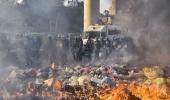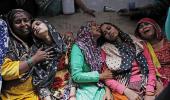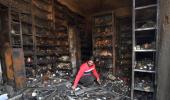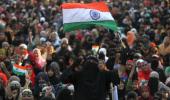'There appears to be no end to the errors that our leaders are willing to commit and no risk they are unwilling to run,' notes Mihir S Sharma.

Ever since the inception of large-scale and peaceful protests against the Citizensship (Amendment) Act and the National Population Register spread across urban India, the ruling Bharatiya Janata Party has struggled to regain control of the narrative.
There was no easy way of making villains of these large crowds of non-violent protesters, frequently led by women, waving the national flag and reading from the Constitution.
It appears that it has now discovered one possible way: What used to be called 'direct action', followed by disinformation.
This approach was debuted in New Delhi's north east, and has swiftly lived up to its dangerous potential.
The violence there has now taken dozens of lives, both Hindu and Muslim, including a policeman.
The hope was that voters from the Hindu community would begin to feel unsafe and insecure because of large-scale Muslim mobilisation; but that end was not achieved during the months of peaceful protests.
A concerted attempt was made to stir up anger against perceived inconveniences caused by the protesters -- but in a country accustomed to strikes, bandhs, political rallies, VIP movements, and just general everyday inconveniences, it is hard for such discontent to congeal into outrage.
Violence on the streets, however, is quite another matter.
When accompanied by the appropriate narrative, it will channel public opinion in the desired direction.
The disinformation that accompanies the violence is of a typically high order, as befits an operation that has been at the cutting edge of the 21st century's alternative-facts breakthroughs.
It is framed as uncontrollable mob violence when reporters on the ground have carefully documented that in the clashes, the police have often been inactive when Muslims are being targeted.
Even occasions when Muslims appear to have been acting in self-defence -- say from the roof of a house that is being threatened with siege -- are being spun as a story of Muslim aggression.
That this spin comes on the anniversary of the horrific death of Ehsan Jafri and his neighbours in Gulberg society is a dark reminder of where this method originates.
After all, the special investigation team investigating that matter had said that Jafri, who had fired perhaps eight rounds from his gun on the violent mob assaulting Gulberg society, had provoked his death.
No statewide violence of the sort that took Jafri's life and hundreds of others is necessary in an age of rampant disinformation.
Fewer, but targeted and carefully-publicised incidents can achieve the same effect -- of stiffening Hindu identity, intimidating Muslims, and inducing further ghettoisation and isolation of minorities.
Collateral damage to the economy and to individual reputations will also be correspondingly less.
It is easy therefore to see the appeal of these tactics.
Of course, if a longer view is taken, the consequences of such deliberately provoked violence and the State's complicity in its execution are disastrous.
It is obvious to any reasonable observer that it is national suicide to set out to sow alienation, disaffection and fear in a large religious minority.
So why has this course been chosen regardless? It is more than political calculation, though surely that plays a part on many, if not most, occasions.
The true reason for choosing such self-destructive tactics is simply that many believe they are necessary.
In other words, too many people, including those in the establishment, simply believe that Muslims are too distinctive, too assertive -- and naturally predisposed towards violence.
Such beliefs throughout history have led to the justification of 'pre-emptive' acts, which is somehow magically rendered through this paranoid lens into self-defence.
Two additional points need to be considered for a full picture of this emerging model of social control.
The first is that political campaigns are now not merely the end point of a process of incitement.
The areas of north east Delhi that were wracked by violence are also those that saw the most effective campaigning by the BJP in the recent assembly election; five of the eight seats the party won are in the region.
The campaign stoked hate; the hate exploded in violence.
The violence begets more hate, which will then be used in the next campaign -- in Bihar later this year, where many of the Purvanchali residents of the area will exercise their franchise.
The second is the repeated reports of 'outsiders' being bused in to stimulate the locals into violence.
This is not the first time that this has happened in recent memory.
There was violence on the streets of Kolkata before the last phase of the general elections that also reportedly featured "outsiders".
As in war, in this strategy of sudden and targeted violence, the aggressor with exceptional resources and ability to move men has an unassailable advantage.
Essentially, this amounts to exporting the neuroses, the resentments and the fury of Uttar Pradesh and Bihar to the rest of the country, through the use of shock troops from these heavily-populated regions.
Thus the front lines being opened are not just religious.
They are regional.
There appears to be no end to the errors that our leaders are willing to commit and no risk they are unwilling to run.











